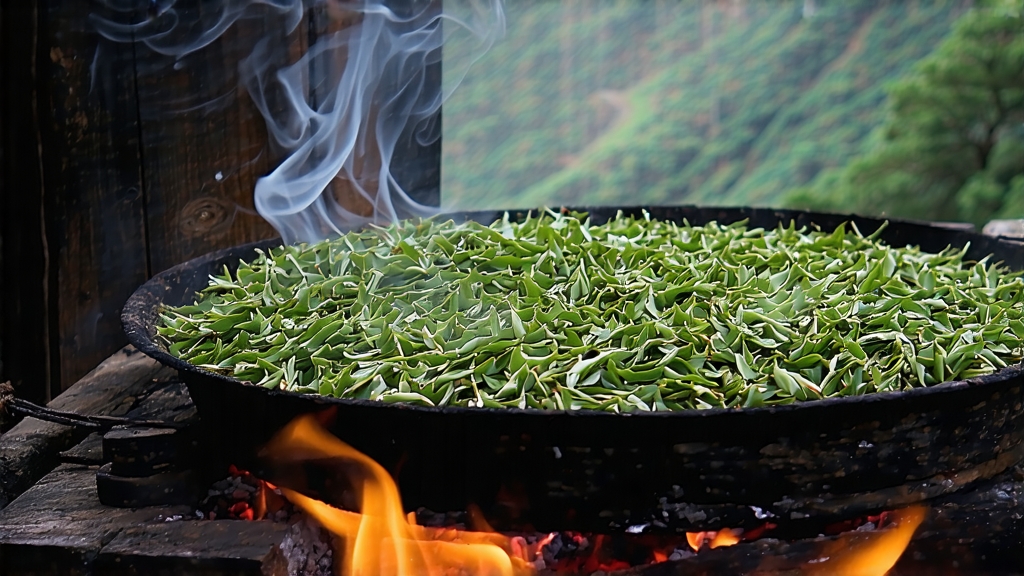
When European tea drinkers first encountered the dark, twisted leaves that produced a liquor as red as Burgundy wine, they did not yet have the word “black tea.” Instead they spoke of “bohea,” a corruption of the Fujianese place-name Wuyi, and they were tasting Lapsang Souchong—the earliest intentionally crafted black tea in the world. Today, while Keemun, Assam and Ceylon fill supermarket shelves, the original story still lingers in the curling smoke above Tongmu Village, where the pine-scented birth of black tea began in the mid-seventeenth century.
History: From Ming-Era Accident to London’s Breakfast Cup
Local legend says Lapsang Souchong was born of military urgency. Qing soldiers, so the tale goes, commandeered a tea factory during harvest season, forcing farmers to speed-dry their half-oxidized leaves over open pine fires so the crop could be moved before the troops returned. Whether myth or marketing, what is documented is that by 1604 Dutch traders were shipping this smoky black tea from the port of Xiamen to Amsterdam, and by 1662 Catherine of Braganza’s dowry chest included chests of “souchon” to charm the English court. The East India Company’s ledgers list it as “Lapsang”—Fujianese dialect for “pine village”—and thus a name, a flavor and an industry crossed the globe.
Terroir: Why Only Tongmu Can Be Authentic
Authentic Lapsang Souchong comes from a 600–1,200 m belt of the Wuyi UNESCO World Heritage site where mist rising from the Nine-Bend River moderates temperature, and acidic, mineral-rich granite soils force slow, flavor-dense growth. Within this micro-climate, the 96-square-kilometer Tongmu Nature Reserve is the legally protected core; here, only indigenous small-leaf cultivars (Camellia sinensis var. sinensis, locally called “cai cha”) may be used, and cutting of the Chinese red pine (Pinus massoniana) for smoking is strictly licensed. Leaves picked even a kilometer outside the boundary, or processed with imported wood, may carry the same shape but never the sweet, resinous balance that connoisseurs recognize as zhengshan xiaozhong—the original “small sort from the true mountain.”
Leaf Grades: From Souchong to Pekoe
The term “souchong” originally referred to the fourth and fifth leaves down the shoot—larger, tougher foliage that tolerated heavy smoke. Higher on the stem, the more tender “orange pekoe” and “pekoe” grades are now lightly smoked or even left unsmoked for a growing niche of “unsmoked Lapsang” that showcases honeyed fruit notes. Top lots are harvested for only three days each spring, when the single bud and first leaf reach the standard of “jin jun mei,” a relative newcomer created in 2005 but already commanding prices above silver. Whatever the grade, the leaf must be strip-shaped, coal-black with golden tips, and release an aroma that balances campfire warmth against dried longan sweetness.
Craft: The Eight Stages of Smoke and Fire
- Wilting: Fresh leaves are spread on bamboo mats in the upper level of the three-story wooden factory, where pine smoke from the ground floor drifts upward for 6–8 hours, softening cellular walls while imparting preliminary aroma.
- Rolling: Once pliable, the leaves are rolled in tight, even strips; ruptured cells begin enzymatic oxidation that will turn leaf edges mahogany.
- Oxidation: In cedar-lined trays the leaves rest 3–5 hours at 24 °C and 80 % humidity, darkening to a uniform copper.
- Primary drying: Over a pine-wood pit fire the leaves are shaken in rattan baskets for 20 minutes, reducing moisture to 20 % and fixing the smoky signature.
- Sorting: Tea masters pick out stems and broken pieces by hand, ensuring only intact strips proceed.
- Secondary smoking: The semi-dry tea is smoked again, this time cooler and slower, for 6–10 hours; resins crystallize on the leaf surface, deepening flavor.
- Final firing: A 90-second high-temperature pass halts residual oxidation and sets the glossy black color.
- Resting: The finished tea is sealed in pine-lined chests for a minimum of 30 days, allowing smoke and leaf volatiles to marry; some